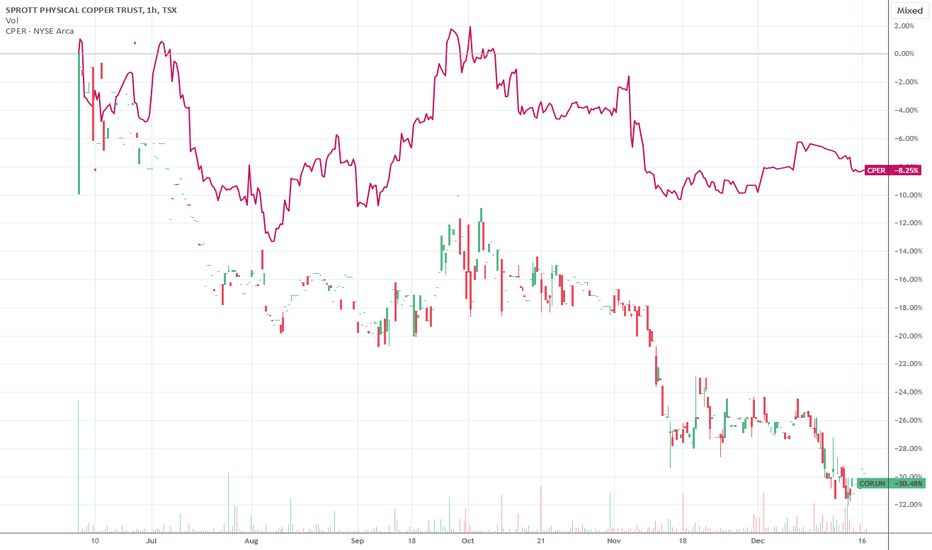Sprott Physical Copper Trust (symbol, COP.UN) traded in Canada COP.UN is showing a big discount of about 20% against NAV
So a buy set up in COP.UN around current levels of about CAD 9,65 could show some nice profits
in the coming months when the discount will probably getting smaller.
Potential upside 20%
Long positions in COP.UN can be hedged by going sh
Key stats
About SPROTT PHYSICAL COPPER TRUST
Home page
Inception date
Jun 6, 2024
Structure
Canadian Commodity Pool (ON)
Dividend treatment
Distributes
Distribution tax treatment
No distributions
Primary advisor
Sprott Asset Management LP
The Trust is the world's first physical copper fund, offering a secure and convenient alternative for investing in copper. It primarily holds long-term Copper assets and uses strategies such as futures contracts and warehouse receipts to enhance value and minimize risks. Copper demand is projected to rise due to global economic recovery, clean energy transitions, and technological advancements, potentially leading to a supply deficit starting this year. The Trust provides daily NAV reporting, lower costs, and logistical support. Copper is stored in reputable CME or LME-approved facilities with insurance against risks like loss, theft, or damage. The Trust adheres to ESG principles, following LME Responsible Sourcing rules, OECD guidelines, and UN Global Compact standards. SAM US advises on futures and other financial instruments. The Trust is unleveraged, only using short-term borrowings to settle trades. Daily NAV reporting ensures transparency.
Classification
Summarizing what the indicators are suggesting.
Oscillators
Neutral
SellBuy
Strong sellStrong buy
Strong sellSellNeutralBuyStrong buy
Oscillators
Neutral
SellBuy
Strong sellStrong buy
Strong sellSellNeutralBuyStrong buy
Summary
Neutral
SellBuy
Strong sellStrong buy
Strong sellSellNeutralBuyStrong buy
Summary
Neutral
SellBuy
Strong sellStrong buy
Strong sellSellNeutralBuyStrong buy
Summary
Neutral
SellBuy
Strong sellStrong buy
Strong sellSellNeutralBuyStrong buy
Moving Averages
Neutral
SellBuy
Strong sellStrong buy
Strong sellSellNeutralBuyStrong buy
Moving Averages
Neutral
SellBuy
Strong sellStrong buy
Strong sellSellNeutralBuyStrong buy
Displays a symbol's price movements over previous years to identify recurring trends.
Related funds
Frequently Asked Questions
An exchange-traded fund (ETF) is a collection of assets (stocks, bonds, commodities, etc.) that track an underlying index and can be bought on an exchange like individual stocks.
COP.U trades at 7.47 USD today, its price has risen 0.95% in the past 24 hours. Track more dynamics on COP.U price chart.
COP.U net asset value is 6.70 today — it's risen 6.10% over the past month. NAV represents the total value of the fund's assets less liabilities and serves as a gauge of the fund's performance.
COP.U assets under management is 72.27 M USD. AUM is an important metric as it reflects the fund's size and can serve as a gauge of how successful the fund is in attracting investors, which, in its turn, can influence decision-making.
COP.U price has fallen by −1.06% over the last month, and its yearly performance shows a −23.70% decrease. See more dynamics on COP.U price chart.
NAV returns, another gauge of an ETF dynamics, showed a 4.56% increase in three-month performance and has increased by 18.67% in a year.
NAV returns, another gauge of an ETF dynamics, showed a 4.56% increase in three-month performance and has increased by 18.67% in a year.
COP.U fund flows account for 7.86 M USD (1 year). Many traders use this metric to get insight into investors' sentiment and evaluate whether it's time to buy or sell the fund.
Since ETFs work like an individual stock, they can be bought and sold on exchanges (e.g. NASDAQ, NYSE, EURONEXT). As it happens with stocks, you need to select a brokerage to access trading. Explore our list of available brokers to find the one to help execute your strategies. Don't forget to do your research before getting to trading. Explore ETFs metrics in our ETF screener to find a reliable opportunity.
No, COP.U isn't leveraged, meaning it doesn't use borrowings or financial derivatives to magnify the performance of the underlying assets or index it follows.
In some ways, ETFs are safe investments, but in a broader sense, they're not safer than any other asset, so it's crucial to analyze a fund before investing. But if your research gives a vague answer, you can always refer to technical analysis.
Today, COP.U technical analysis shows the sell rating and its 1-week rating is sell. Since market conditions are prone to changes, it's worth looking a bit further into the future — according to the 1-month rating COP.U shows the sell signal. See more of COP.U technicals for a more comprehensive analysis.
Today, COP.U technical analysis shows the sell rating and its 1-week rating is sell. Since market conditions are prone to changes, it's worth looking a bit further into the future — according to the 1-month rating COP.U shows the sell signal. See more of COP.U technicals for a more comprehensive analysis.
No, COP.U doesn't pay dividends to its holders.
COP.U trades at a premium (10.53%).
Premium/discount to NAV expresses the difference between the ETF’s price and its NAV value. A positive percentage indicates a premium, meaning the ETF trades at a higher price than the calculated NAV. Conversely, a negative percentage indicates a discount, suggesting the ETF trades at a lower price than NAV.
Premium/discount to NAV expresses the difference between the ETF’s price and its NAV value. A positive percentage indicates a premium, meaning the ETF trades at a higher price than the calculated NAV. Conversely, a negative percentage indicates a discount, suggesting the ETF trades at a lower price than NAV.
COP.U shares are issued by Sprott, Inc.
COP.U follows the LME Copper Spot Price - CAD - Benchmark Price Return. ETFs usually track some benchmark seeking to replicate its performance and guide asset selection and objectives.
The fund started trading on Jun 6, 2024.
The fund's management style is passive, meaning it's aiming to replicate the performance of the underlying index by holding assets in the same proportions as the index. The goal is to match the index's returns.
